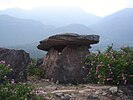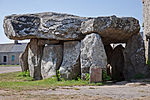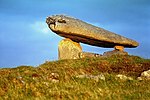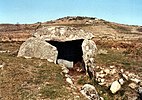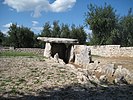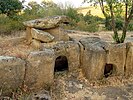Dolmen: Difference between revisions
→History: Structure. 1. Tags: Mobile edit Mobile web edit |
→Germanic: The etymological meaning of the Korean language is added, as likely as old Sumerian language (abi. ama, gal-abi, gal-ama, axa-abi, axa-ama, dug, sir etc.) and b/vul (Germanic 'Feur', Dutch 'vuur'). Tags: Mobile edit Mobile web edit |
||
| (45 intermediate revisions by 16 users not shown) | |||
| Line 5: | Line 5: | ||
A '''dolmen''' ({{IPAc-en|ˈ|d|ɒ|l|m|ɛ|n}}) or '''portal tomb''' is a type of single-chamber [[Megalith#Tombs|megalithic tomb]], usually consisting of two or more upright [[megalith]]s supporting a large flat horizontal capstone or "table". Most date from the [[Late Neolithic]] period (4000{{ndash}}3000 BCE) and were sometimes covered with earth or smaller stones to form a [[tumulus]] (burial mound). Small pad-stones may be wedged between the cap and supporting stones to achieve a level appearance.{{sfnp|Murphy|1997|p=43}} In many instances, the covering has eroded away, leaving only the stone "skeleton". |
A '''dolmen''' ({{IPAc-en|ˈ|d|ɒ|l|m|ɛ|n}}) or '''portal tomb''' is a type of single-chamber [[Megalith#Tombs|megalithic tomb]], usually consisting of two or more upright [[megalith]]s supporting a large flat horizontal capstone or "table". Most date from the [[Late Neolithic]] period (4000{{ndash}}3000 BCE) and were sometimes covered with earth or smaller stones to form a [[tumulus]] (burial mound). Small pad-stones may be wedged between the cap and supporting stones to achieve a level appearance.{{sfnp|Murphy|1997|p=43}} In many instances, the covering has eroded away, leaving only the stone "skeleton". |
||
==Etymology== |
|||
The [[Korean Peninsula]] is home to the world's highest concentration of dolmens,<ref name="UNESCO">{{Cite web |last=Centre |first=UNESCO World Heritage |title=Gochang, Hwasun and Ganghwa Dolmen Sites |url=https://whc.unesco.org/en/list/977/ |access-date=2023-01-19 |website=UNESCO World Heritage Centre |language=en}}</ref> including "cemeteries" consisting of 30–100 examples located in close proximity to each other.<ref name="WorldHistoryEncyc">{{cite web|url=https://www.worldhistory.org/article/987/dolmens-of-ancient-korea/|title="Dolmens of Ancient Korea"|date=1 December 2016}}</ref> With over 35,000 dolmens,<ref name="auto">{{cite book|last1=Jensen|first1=John Jr.|title=Earth Epochs: Cataclysms across the Holocene|publisher=John Jensen|page=276|url=https://books.google.com/books?id=EfxiCAAAQBAJ&q=dolmen+in+korea+40%25&pg=PA276|access-date=4 March 2016}}</ref> Korea accounts for approximately 40% of the global total.<ref name="auto" /><ref name="AsiaSocietyDolmen">{{cite web|url=https://asiasociety.org/korea/unesco-world-heritage-series-part-1-dolmens|title=UNESCO World Heritage Series: Part 1 – Dolmens|date=January 2017}}</ref><ref name="BritannicaDolmen">{{cite encyclopedia|url=https://www.britannica.com/topic/dolmen|title="Dolmen"|encyclopedia=Encyclopedia Britannica|date=31 July 2015}}</ref> |
|||
| ⚫ | |||
==History== |
|||
| ⚫ | |||
| ⚫ | It remains unclear when, why and by whom the earliest dolmens were made. The oldest known are found in [[Western Europe]], dating from c. 7,000 years ago. Archaeologists still do not know who erected these dolmens, which makes it difficult to know why they did it. They are generally all regarded as tombs or burial chambers, despite the absence of clear evidence for this. Human remains, sometimes accompanied by artefacts, have been found in or close to the dolmens which could be scientifically dated using [[radiocarbon dating]]. However, it has been impossible to prove that these remains date from the time when the stones were originally set in place.<ref>Lewis, S. (2009) ''Guide to the Menhirs and other Megaliths of Central Brittany'', Nezert Books, {{ISBN|978-9522705952}}</ref> |
||
| ⚫ | |||
The word ''dolmen'' entered archaeology when [[Théophile Corret de la Tour d'Auvergne]] used it to describe megalithic tombs in his {{Lang|fr|Origines gauloises}} (1796) using the spelling ''dolmin'' (the current spelling was introduced about a decade later and had become standard in French by about 1885).<ref>{{cite book|last=Bakker|first=Jan Albert|title=Megalithic Research in the Netherlands, 1547–1911|url=https://archive.org/details/bub_gb_MQiK5ATCL1wC|year=2009|publisher=Sidestone Press|isbn=978-9088900341 |page=36}}</ref><ref>Corret de la Tour d'Auvergne, {{google books|vmpAAAAAcAAJ|Origines gauloises. Celles des plus anciens peuples de l'Europe puisées dans leur vraie source ou recherche sur la langue, l'origine et les antiquités des Celto-bretons de l'Armorique, pour servir à l'histoire ancienne et moderne de ce peuple et à celle des Français|page=PR1}}, 1796–97.</ref> The ''[[Oxford English Dictionary]]'' does not mention ''dolmin'' in English and gives its first citation for ''dolmen'' from a book on [[Brittany]] in 1859, describing the word as "The French term, used by some English authors, for a [[cromlech]] ...". The name was supposedly derived from a [[Breton language]] term meaning '[[stone table]]' but doubt has been cast on this,{{citation needed|date=January 2023}} and the ''OED'' describes its origin as "Modern French". A book on [[Cornwall|Cornish]] antiquities from 1754 said that the current term in the [[Cornish language]] for a cromlech was {{Lang|kw|tolmen}} ('hole of stone') and the OED says that "There is reason to think that this was the term inexactly reproduced by Latour d'Auvergne [sic] as ''dolmen'', and misapplied by him and succeeding French archaeologists to the ''cromlech''".<ref>''[[OED]]'' "Dolmen", 1st edition, 1897</ref> Nonetheless it has now replaced ''cromlech'' as the usual English term in archaeology, when the more technical and descriptive alternatives are not used. The later Cornish term was [[wikt:quoit|''quoit'']] – an English-language word for an object with a hole through the middle preserving the original Cornish language term of {{Lang|kw|tolmen}} – the name of another dolmen-like monument is in fact [[Mên-an-Tol]] 'stone with hole' (Standard Written Form: ''Men An Toll''.)<ref>{{Cite web|url=https://www.theguardian.com/uk/1999/nov/12/maevkennedy1|title = Vandals threaten stone age monuments| website=[[TheGuardian.com]] |date = 12 November 1999}}</ref> |
The word ''dolmen'' entered archaeology when [[Théophile Corret de la Tour d'Auvergne]] used it to describe megalithic tombs in his {{Lang|fr|Origines gauloises}} (1796) using the spelling ''dolmin'' (the current spelling was introduced about a decade later and had become standard in French by about 1885).<ref>{{cite book|last=Bakker|first=Jan Albert|title=Megalithic Research in the Netherlands, 1547–1911|url=https://archive.org/details/bub_gb_MQiK5ATCL1wC|year=2009|publisher=Sidestone Press|isbn=978-9088900341 |page=36}}</ref><ref>Corret de la Tour d'Auvergne, {{google books|vmpAAAAAcAAJ|Origines gauloises. Celles des plus anciens peuples de l'Europe puisées dans leur vraie source ou recherche sur la langue, l'origine et les antiquités des Celto-bretons de l'Armorique, pour servir à l'histoire ancienne et moderne de ce peuple et à celle des Français|page=PR1}}, 1796–97.</ref> The ''[[Oxford English Dictionary]]'' does not mention ''dolmin'' in English and gives its first citation for ''dolmen'' from a book on [[Brittany]] in 1859, describing the word as "The French term, used by some English authors, for a [[cromlech]] ...". The name was supposedly derived from a [[Breton language]] term meaning '[[stone table]]' but doubt has been cast on this,{{citation needed|date=January 2023}} and the ''OED'' describes its origin as "Modern French". A book on [[Cornwall|Cornish]] antiquities from 1754 said that the current term in the [[Cornish language]] for a cromlech was {{Lang|kw|tolmen}} ('hole of stone') and the OED says that "There is reason to think that this was the term inexactly reproduced by Latour d'Auvergne [sic] as ''dolmen'', and misapplied by him and succeeding French archaeologists to the ''cromlech''".<ref>''[[OED]]'' "Dolmen", 1st edition, 1897</ref> Nonetheless it has now replaced ''cromlech'' as the usual English term in archaeology, when the more technical and descriptive alternatives are not used. The later Cornish term was [[wikt:quoit|''quoit'']] – an English-language word for an object with a hole through the middle preserving the original Cornish language term of {{Lang|kw|tolmen}} – the name of another dolmen-like monument is in fact [[Mên-an-Tol]] 'stone with hole' (Standard Written Form: ''Men An Toll''.)<ref>{{Cite web|url=https://www.theguardian.com/uk/1999/nov/12/maevkennedy1|title = Vandals threaten stone age monuments| website=[[TheGuardian.com]] |date = 12 November 1999}}</ref> |
||
In [[Irish Gaelic]] they are called {{lang-ga|dolmain}}.<ref>{{Cite web|title=dolmen – Translation to Irish Gaelic with audio pronunciation of translations for dolmen by New English-Irish Dictionary|url=https://www.focloir.ie/en/dictionary/ei/dolmen|access-date=2020-11-26|website=www.focloir.ie}}</ref> |
|||
| ⚫ | |||
===Germanic=== |
|||
Dolmens are known by a variety of names in other languages, including [[Galician language|Galician]] and {{lang-pt|anta}}, {{lang-bg|translit=Dolmeni|Долмени}}, {{lang-de|Hünengrab/Hünenbett}}, [[Afrikaans]] and {{lang-nl|hunebed}}, {{lang-eu|trikuharri}}, [[Abkhaz language|Abkhaz]]: {{Lang|ab-latn|Adamra}}, [[Adyghe language|Adyghe]]: {{Lang|ady-latn|Ispun}} |
|||
| ⚫ | [[Danish language|Danish]] and {{lang-no|dysse}}, {{lang-sv|dös}}, {{lang-ko|translit=goindol (go-in = 'propped' + dol = 'stone')|고인돌}}, and {{lang-he|גַלעֵד}}. [[:wikt:granja|''Granja'']] is used in [[Portugal]], [[Galicia (Spain)|Galicia]], and some parts of [[Spain]].{{cn|date=February 2022}} The rarer forms ''anta'' and ''ganda'' also appear. In [[Catalan language|Catalan-speaking areas]], they are known simply as {{Lang|ca|dolmen}}, but also by a variety of folk names, including {{Lang|ca|cova}} ('cave'),<ref name=GEC>{{Cite GREC|dolmen|title=Dolmen}}</ref> {{Lang|ca|caixa}} ('crate' or 'coffin'),<ref name=caixa>Alcover, Antoni M.; Moll, Francesc de B. [https://dcvb.iec.cat/results.asp "caixa"] (in Catalan). In: ''Diccionari català-valencià-balear''. Palma: Moll, 1930–1962. {{ISBN|8427300255}}.</ref> {{Lang|ca|taula}} ('table'),<ref name=taula>Alcover, Antoni M.; Moll, Francesc de B. [https://dcvb.iec.cat/results.asp "taula"] (in Catalan). In: ''Diccionari català-valencià-balear''. Palma: Moll, 1930–1962. {{ISBN|8427300255}}.</ref> {{Lang|ca|arca}} ('chest'),<ref name=GEC/> {{Lang|ca|cabana}} ('hut'), {{Lang|ca|barraca}} ('hut'), {{Lang|ca|llosa}} ('slab'), {{Lang|ca|llosa de jaça}} ('pallet slab'),<ref>Alcover, Antoni M.; Moll, Francesc de B. [https://dcvb.iec.cat/results.asp "llosa de jaça"] (in Catalan). In: ''Diccionari català-valencià-balear''. Palma: Moll, 1930–1962. {{ISBN|8427300255}}.</ref> {{Lang|ca|roca}} ('rock') or {{Lang|ca|pedra}} ('stone'), usually combined with a second part such as {{Lang|la|de l'alarb}} ('of the Arab'),<ref name=caixa/> {{Lang|ca|del/de moro/s}} ('of the Moor/s'),<ref name=caixa/><ref>Alcover, Antoni M.; Moll, Francesc de B. [https://dcvb.iec.cat/results.asp "cova"] (in Catalan). In: ''Diccionari català-valencià-balear''. Palma: Moll, 1930–1962. {{ISBN|8427300255}}.</ref> {{Lang|ca|del lladre}} ('of the thief'), {{Lang|ca|del dimoni}} ('of the devil'), {{Lang|ca|d'en Rotllà/Rotllan/Rotlan/Roldan}} ('of [[Roland]]'),<ref name=taula/><ref name=caixa/>. In the [[Basque Country (greater region)|Basque Country]], they are attributed to the ''[[jentil]]ak'', a race of giants. |
||
The [[etymology]] of the {{lang-de|Hünenbett, Hünengrab}} and {{lang-nl|hunebed}} – with {{Lang|de|Hüne}}''/''{{Lang|nl|hune}} meaning 'giant' – all evoke the image of [[Giant (mythology)|giants]] buried ({{Lang|de|bett}}/{{Lang|nl|bed}}/{{Lang|de|grab}} = 'bed/grave') there. Of other [[Celtic languages]], [[Welsh language|Welsh]] {{Lang|cy|cromlech}} was borrowed into English and ''quoit'' is commonly used in English in [[Cornwall]]. |
The [[etymology]] of the {{lang-de|Hünenbett, Hünengrab}} and {{lang-nl|hunebed}} – with {{Lang|de|Hüne}}''/''{{Lang|nl|hune}} meaning 'giant' – all evoke the image of [[Giant (mythology)|giants]] buried ({{Lang|de|bett}}/{{Lang|nl|bed}}/{{Lang|de|grab}} = 'bed/grave') there. Of other [[Celtic languages]], [[Welsh language|Welsh]] {{Lang|cy|cromlech}} was borrowed into English and ''quoit'' is commonly used in English in [[Cornwall]]. |
||
==Western Europe== |
|||
== Korean dolmens == |
|||
===Origin and purpose=== |
|||
| ⚫ | |||
| ⚫ | It remains unclear when, why and by whom the earliest dolmens were made.{{dubious|date=November 2023}} The oldest known are found in [[Western Europe]], dating from c. 7,000 years ago. Archaeologists still do not know who erected these dolmens, which makes it difficult to know why they did it. They are generally all regarded as tombs or burial chambers, despite the absence of clear evidence for this. Human remains, sometimes accompanied by artefacts, have been found in or close to the dolmens which could be scientifically dated using [[radiocarbon dating]]. However, it has been impossible to prove that these remains date from the time when the stones were originally set in place.<ref>Lewis, S. (2009) ''Guide to the Menhirs and other Megaliths of Central Brittany'', Nezert Books, {{ISBN|978-9522705952}}</ref> |
||
==Middle East== |
|||
| ⚫ | They are mainly distributed along the West Sea coastal area and on large rivers from the Liaoning region of China (the [[Liaodong Peninsula]]) to [[South Jeolla Province|Jeollanam-do]]. In North Korea, they are concentrated around the [[Taedong River|Taedong]] and [[Chaeryong River|Jaeryeong Rivers]]. In South Korea, they are found in dense |
||
Dolmens can be found in the [[Levant]], some along the [[Jordan Rift Valley]] ([[Upper Galilee]] in [[Israel]], the [[Golan Heights]],<ref name=FIAA>[https://www.friendsofiaa.org/news/2020/7/12/megalithic-structures-in-the-golan-and-the-galilee-reveal-rock-art-of-a-mysterious-ancient-culture Megalithic Structures in the Golan and the Galilee Reveal Rock Art of a Mysterious Ancient Culture], Friends of the [[Israel Antiquities Authority]], New York,12 July 2020. Accessed 12 Nov 2023.</ref> [[Jordan]], [[Lebanon]], [[Syria]], and southeast [[Turkey]].<ref name=Fraser18>James A. Fraser, ''Dolmens in the Levant'', 1st Edition 2018: [https://www.routledge.com/Dolmens-in-the-Levant/Fraser/p/book/9780367891954 "Description"]. Routledge homepage. Access 12 Nov 2023.</ref><ref>{{Citation|last=Fraser|first=James A.|title=Approaching dolmens in the Levant|year=2018|url=http://dx.doi.org/10.4324/9781315147796-1|work=Dolmens in the Levant|pages=3–9|location=Abingdon, Oxon|publisher=Routledge|doi=10.4324/9781315147796-1 |isbn=9781315147796 |access-date=2021-12-22}}</ref> |
|||
Dolmens in the Levant belong to a different, unrelated tradition to that of Europe, although they are often treated "as part of a trans-regional phenomenon that spanned the [[Taurus mountains]] to the [[Arabian peninsula]]."<ref name=Fraser18/> In the Levant, they are of [[Early Bronze Age|Early Bronze]] rather than [[Late Neolithic]]al age.<ref name=Fraser18/> They are mostly found along the Jordan Rift Valley's eastern escarpment, and in the hills of the Galilee, in clusters near Early Bronze I [[Proto-city|proto-urban settlements]] (3700–3000 BCE), additionally restricted by geology to areas allowing the quarrying of slabs of megalithic size.<ref name=Fraser18/> In the Levant, geological constraints led to a local burial tradition with a variety of tomb forms, dolmens being one of them.<ref name=Fraser18/> |
|||
==Korea== |
|||
| ⚫ | |||
| ⚫ | Dolmens were built in Korea from the Bronze Age to the early Iron Age, with about 40,000 to be found throughout the peninsula.<ref name=":0">{{Cite web |title=고인돌 Dolmen |url=https://encykorea.aks.ac.kr/Article/E0003901 |access-date=2023-11-10 |website=[[Encyclopedia of Korean Culture]] |language=ko}}</ref> In 2000,<ref name=":0" /> the dolmen groups of Jukrim-ri and Dosan-ri in [[Gochang County|Gochang]], Hyosan-ri and Daesin-ri in [[Hwasun County|Hwasun]], and Bujeong-ri, Samgeori and Osang-ri in [[Ganghwa Island|Ganghwa]] gained World Cultural Heritage status.<ref>{{Cite web |date=2007-03-24 |title=Korean National Heritage Online |url=http://www.heritage.go.kr/eng/her/her_08.jsp |access-date=2023-11-10 |archive-url=https://web.archive.org/web/20070324210503/http://www.heritage.go.kr/eng/her/her_08.jsp |archive-date=2007-03-24 }}</ref> (See [[Gochang, Hwasun and Ganghwa Dolmen Sites]].) |
||
| ⚫ | They are mainly distributed along the West Sea coastal area and on large rivers from the Liaoning region of China (the [[Liaodong Peninsula]]) to [[South Jeolla Province|Jeollanam-do]]. In North Korea, they are concentrated around the [[Taedong River|Taedong]] and [[Chaeryong River|Jaeryeong Rivers]]. In South Korea, they are found in dense concentrations in river basins, such as the [[Han River (Korea)|Han]] and [[Nakdong River|Nakdong Rivers]], and in the west coast area ([[Boryeong]] in South Chungcheong Province, [[Buan County|Buan]] in North Jeolla Province, and Jeollanam-do.<ref name=":0" /> They are mainly found on sedimentary plains, where they are grouped in rows parallel to the direction of the river or stream.<ref name=":0" /> Those found in hilly areas are grouped in the direction of the hill.<ref name=":0" /> |
||
== Types == |
== Types == |
||
| Line 33: | Line 45: | ||
File:Trethevy Quoit from the South - geograph.org.uk - 362250.jpg|[[Trethevy Quoit]] – one of the best-preserved in [[Cornwall]], UK dated to around 3500–2500 BCE |
File:Trethevy Quoit from the South - geograph.org.uk - 362250.jpg|[[Trethevy Quoit]] – one of the best-preserved in [[Cornwall]], UK dated to around 3500–2500 BCE |
||
File:Chûn Quoit (small).jpg|[[Chûn Quoit]] in Cornwall, UK, about 2400 BCE |
File:Chûn Quoit (small).jpg|[[Chûn Quoit]] in Cornwall, UK, about 2400 BCE |
||
File:Zennor Quoit (small) (9612120).jpg|[[Zennor Quoit]] in Cornwall, UK, 2500–1500 BCE |
|||
File:Lanyon Quoit 05.jpg|[[Lanyon Quoit]] in Cornwall, UK, 3500–2500 BCE |
File:Lanyon Quoit 05.jpg|[[Lanyon Quoit]] in Cornwall, UK, 3500–2500 BCE |
||
File:MarayoorDolmen.JPG|A dolmen erected by Neolithic people in [[Marayur]], [[Kerala, India]]. |
File:MarayoorDolmen.JPG|A dolmen erected by Neolithic people in [[Marayur]], [[Kerala, India]]. |
||
File:Muniyara.jpg|Dolmens of [[Marayoor]], India. |
File:Muniyara.jpg|Dolmens of [[Marayoor]], India. |
||
File:Example of a southern-style dolmen at Ganghwa Island.jpg|A southern-style dolmen at [[Ganghwa Island]], [[South Korea]] |
File:Example of a southern-style dolmen at Ganghwa Island.jpg|A southern-style dolmen at [[Ganghwa Island]], [[South Korea]] |
||
File:Example of a northern-style dolmen at Ganghwa Island.jpg|A northern-style dolmen at Ganghwa Island, South Korea |
|||
File:Korea-Hwasun Dolmen sites03.jpg|The biggest dolmen near [[Hwasun]], [[South Korea]] |
File:Korea-Hwasun Dolmen sites03.jpg|The biggest dolmen near [[Hwasun]], [[South Korea]] |
||
File:Dolmen Roch-Feutet.JPG|The dolmen Er-Roc'h-Feutet in [[Carnac]], [[Brittany]], France |
File:Dolmen Roch-Feutet.JPG|The dolmen Er-Roc'h-Feutet in [[Carnac]], [[Brittany]], France |
||
| Line 48: | Line 58: | ||
File:Dolmen di Avola.JPG|Dolmen of Avola, Sicily |
File:Dolmen di Avola.JPG|Dolmen of Avola, Sicily |
||
File:Bisceglie dolmen della chianca 5.JPG|Dolmen of [[Bisceglie]], [[Apulia]] |
File:Bisceglie dolmen della chianca 5.JPG|Dolmen of [[Bisceglie]], [[Apulia]] |
||
File:Inukshuk Sunset Kuujjuaraapik January.jpg|Inuksuk in the vicinity of [[Kuujjuarapik]], Quebec |
|||
File:12i dolmen di Montalbano.jpg|Dolmen of Fasano, Apulia |
File:12i dolmen di Montalbano.jpg|Dolmen of Fasano, Apulia |
||
File:Tinkinswood burial chamber (4787).jpg|[[Tinkinswood]], [[Vale of Glamorgan]], Wales, around 3000 BCE |
File:Tinkinswood burial chamber (4787).jpg|[[Tinkinswood]], [[Vale of Glamorgan]], Wales, around 3000 BCE |
||
| Line 55: | Line 64: | ||
File:Dolmen Russia Kavkaz Jane 1.jpg|[[Russia]] |
File:Dolmen Russia Kavkaz Jane 1.jpg|[[Russia]] |
||
File:Долмен Начови чаири.jpg|[[Bulgaria]] |
File:Долмен Начови чаири.jpg|[[Bulgaria]] |
||
File:Dombate perfil 2013.jpg|Musealised Dolmen de Dombate, [[Galicia (Spain)]] |
|||
File:Dolmen-Keriaval.jpg|Keriaval Dolmen, [[Carnac]], [[Brittany]], France |
File:Dolmen-Keriaval.jpg|Keriaval Dolmen, [[Carnac]], [[Brittany]], France |
||
File:Temuan Kolonial Belanda.jpg|Dolmen Batu Brak in [[Sumatra]]. [[Liwa, Indonesia]]. |
|||
</gallery> |
</gallery> |
||
== See also == |
== See also == |
||
{{Div col}} |
{{Div col}} |
||
* [[Antequera Dolmens Site]] |
|||
* [[Gochang, Hwasun and Ganghwa Dolmen Sites]] |
|||
* [[Irish megalithic tombs]] |
* [[Irish megalithic tombs]] |
||
* [[Kistvaen]] |
|||
* [[List of dolmens]] |
* [[List of dolmens]] |
||
* [[List of megalithic sites]] |
* [[List of megalithic sites]] |
||
* [[Megalithic art]] |
* [[Megalithic art]] |
||
* [[Megalithic sites in Pyrénées-Orientales]] |
|||
* [[Neolithic Europe]] |
* [[Neolithic Europe]] |
||
* [[Nordic megalith architecture]] |
* [[Nordic megalith architecture]] |
||
* [[Rujm el-Hiri]] |
|||
* [[Taula]] |
|||
{{Div col end}} |
{{Div col end}} |
||
| Line 79: | Line 80: | ||
{{Reflist|30em}} |
{{Reflist|30em}} |
||
=== |
=== Works cited === |
||
| ⚫ | |||
| ⚫ | |||
| ⚫ | |||
| ⚫ | |||
== Further reading == |
== Further reading == |
||
* {{ |
* {{cite book |last=Cooney |first=Gabriel |title=Death in Irish Prehistory |place=Dublin |publisher=[[Royal Irish Academy]] |year=2023 |isbn=978-1-8020-5009-7 |ref=none}} |
||
| ⚫ | |||
* {{cite book |last=Knight |first=Peter |title=Ancient Stones of Dorset |year=1996 |publisher=Power Publications |isbn=978-1898073123 |ref=none}} |
|||
| ⚫ | |||
== External links == |
== External links == |
||
{{external links|date=February 2024}} |
|||
{{Commons|Dolmen}} |
{{Commons|Dolmen}} |
||
{{Wiktionary|dolmen}} |
{{Wiktionary|dolmen}} |
||
* [https://web.archive.org/web/20070324210503/http://www.heritage.go.kr/eng/her/her_08.jsp World heritage site of dolmen in Korea] |
* [https://web.archive.org/web/20070324210503/http://www.heritage.go.kr/eng/her/her_08.jsp World heritage site of dolmen in Korea] |
||
* [https://www.worldhistory.org/dolmen/. Piccolo, Salvatore. "Dolmen." World History Encyclopedia.] |
|||
* [https://www.google.com/maps/d/viewer?mid=1KaV195j0kPMHJfm2Qa9U5a461eA The Megalith Map] |
* [https://www.google.com/maps/d/viewer?mid=1KaV195j0kPMHJfm2Qa9U5a461eA The Megalith Map] |
||
* [http://www.megalithic.co.uk/ The Megalithic Portal and Megalith Map] |
* [http://www.megalithic.co.uk/ The Megalithic Portal and Megalith Map] |
||
| Line 99: | Line 100: | ||
* [https://www.ringingcedarsofrussia.org/dolmens/ Dolmens of Russia] |
* [https://www.ringingcedarsofrussia.org/dolmens/ Dolmens of Russia] |
||
* [https://rgdn.info/en/dolmeny._chast_2._kak_stroilis_i_zachem_gipotezy Dolmens. Part 2. How and for which purpose were they built? Hypotheses] |
* [https://rgdn.info/en/dolmeny._chast_2._kak_stroilis_i_zachem_gipotezy Dolmens. Part 2. How and for which purpose were they built? Hypotheses] |
||
{{European Standing Stones}} |
{{European Standing Stones}} |
||
{{Neolithic Europe}} |
{{Neolithic Europe}} |
||
{{Prehistoric technology}} |
{{Prehistoric technology}} |
||
{{Authority control}} |
{{Authority control}} |
||
| Line 114: | Line 115: | ||
[[Category:Megalithic monuments in the Middle East]] |
[[Category:Megalithic monuments in the Middle East]] |
||
[[Category:Stone Age Europe]] |
[[Category:Stone Age Europe]] |
||
[[Category:4th-millennium BC architecture]] |
|||
Revision as of 06:35, 4 May 2024

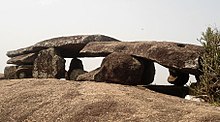
A dolmen (/ˈdɒlmɛn/) or portal tomb is a type of single-chamber megalithic tomb, usually consisting of two or more upright megaliths supporting a large flat horizontal capstone or "table". Most date from the Late Neolithic period (4000–3000 BCE) and were sometimes covered with earth or smaller stones to form a tumulus (burial mound). Small pad-stones may be wedged between the cap and supporting stones to achieve a level appearance.[1] In many instances, the covering has eroded away, leaving only the stone "skeleton".
Etymology
Celtic
The word dolmen entered archaeology when Théophile Corret de la Tour d'Auvergne used it to describe megalithic tombs in his Origines gauloises (1796) using the spelling dolmin (the current spelling was introduced about a decade later and had become standard in French by about 1885).[2][3] The Oxford English Dictionary does not mention dolmin in English and gives its first citation for dolmen from a book on Brittany in 1859, describing the word as "The French term, used by some English authors, for a cromlech ...". The name was supposedly derived from a Breton language term meaning 'stone table' but doubt has been cast on this,[citation needed] and the OED describes its origin as "Modern French". A book on Cornish antiquities from 1754 said that the current term in the Cornish language for a cromlech was tolmen ('hole of stone') and the OED says that "There is reason to think that this was the term inexactly reproduced by Latour d'Auvergne [sic] as dolmen, and misapplied by him and succeeding French archaeologists to the cromlech".[4] Nonetheless it has now replaced cromlech as the usual English term in archaeology, when the more technical and descriptive alternatives are not used. The later Cornish term was quoit – an English-language word for an object with a hole through the middle preserving the original Cornish language term of tolmen – the name of another dolmen-like monument is in fact Mên-an-Tol 'stone with hole' (Standard Written Form: Men An Toll.)[5]
In Irish Gaelic they are called Irish: dolmain.[6]
Germanic
Dolmens are known by a variety of names in other languages, including Galician and Portuguese: anta, Bulgarian: Долмени, romanized: Dolmeni, German: Hünengrab/Hünenbett, Afrikaans and Dutch: hunebed, Basque: trikuharri, Abkhaz: Adamra, Adyghe: Ispun
Danish and Norwegian: dysse, Swedish: dös, Korean: 고인돌, romanized: goindol (go-in = 'propped' + dol = 'stone'), and Hebrew: גַלעֵד. Granja is used in Portugal, Galicia, and some parts of Spain.[citation needed] The rarer forms anta and ganda also appear. In Catalan-speaking areas, they are known simply as dolmen, but also by a variety of folk names, including cova ('cave'),[7] caixa ('crate' or 'coffin'),[8] taula ('table'),[9] arca ('chest'),[7] cabana ('hut'), barraca ('hut'), llosa ('slab'), llosa de jaça ('pallet slab'),[10] roca ('rock') or pedra ('stone'), usually combined with a second part such as de l'alarb ('of the Arab'),[8] del/de moro/s ('of the Moor/s'),[8][11] del lladre ('of the thief'), del dimoni ('of the devil'), d'en Rotllà/Rotllan/Rotlan/Roldan ('of Roland'),[9][8]. In the Basque Country, they are attributed to the jentilak, a race of giants.
The etymology of the German: Hünenbett, Hünengrab and Dutch: hunebed – with Hüne/hune meaning 'giant' – all evoke the image of giants buried (bett/bed/grab = 'bed/grave') there. Of other Celtic languages, Welsh cromlech was borrowed into English and quoit is commonly used in English in Cornwall.
Western Europe
Origin and purpose
It remains unclear when, why and by whom the earliest dolmens were made.[dubious ] The oldest known are found in Western Europe, dating from c. 7,000 years ago. Archaeologists still do not know who erected these dolmens, which makes it difficult to know why they did it. They are generally all regarded as tombs or burial chambers, despite the absence of clear evidence for this. Human remains, sometimes accompanied by artefacts, have been found in or close to the dolmens which could be scientifically dated using radiocarbon dating. However, it has been impossible to prove that these remains date from the time when the stones were originally set in place.[12]
Middle East
Dolmens can be found in the Levant, some along the Jordan Rift Valley (Upper Galilee in Israel, the Golan Heights,[13] Jordan, Lebanon, Syria, and southeast Turkey.[14][15]
Dolmens in the Levant belong to a different, unrelated tradition to that of Europe, although they are often treated "as part of a trans-regional phenomenon that spanned the Taurus mountains to the Arabian peninsula."[14] In the Levant, they are of Early Bronze rather than Late Neolithical age.[14] They are mostly found along the Jordan Rift Valley's eastern escarpment, and in the hills of the Galilee, in clusters near Early Bronze I proto-urban settlements (3700–3000 BCE), additionally restricted by geology to areas allowing the quarrying of slabs of megalithic size.[14] In the Levant, geological constraints led to a local burial tradition with a variety of tomb forms, dolmens being one of them.[14]
Korea
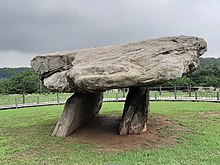
Dolmens were built in Korea from the Bronze Age to the early Iron Age, with about 40,000 to be found throughout the peninsula.[16] In 2000,[16] the dolmen groups of Jukrim-ri and Dosan-ri in Gochang, Hyosan-ri and Daesin-ri in Hwasun, and Bujeong-ri, Samgeori and Osang-ri in Ganghwa gained World Cultural Heritage status.[17] (See Gochang, Hwasun and Ganghwa Dolmen Sites.)
They are mainly distributed along the West Sea coastal area and on large rivers from the Liaoning region of China (the Liaodong Peninsula) to Jeollanam-do. In North Korea, they are concentrated around the Taedong and Jaeryeong Rivers. In South Korea, they are found in dense concentrations in river basins, such as the Han and Nakdong Rivers, and in the west coast area (Boryeong in South Chungcheong Province, Buan in North Jeolla Province, and Jeollanam-do.[16] They are mainly found on sedimentary plains, where they are grouped in rows parallel to the direction of the river or stream.[16] Those found in hilly areas are grouped in the direction of the hill.[16]
Types
- Great dolmen – Type of dolmen in Nordic megalith architecture
- Inuksuk – Inuit built stone landmark or cairn
- Polygonal dolmen – Type of dolmen with five to nine supporting stones
- Rectangular dolmen – Rectangular, enlarged or extended dolmen
- Simple dolmen – Early form of dolmen or megalithic tomb
-
Trethevy Quoit – one of the best-preserved in Cornwall, UK dated to around 3500–2500 BCE
-
Chûn Quoit in Cornwall, UK, about 2400 BCE
-
Lanyon Quoit in Cornwall, UK, 3500–2500 BCE
-
A dolmen erected by Neolithic people in Marayur, Kerala, India.
-
Dolmens of Marayoor, India.
-
A southern-style dolmen at Ganghwa Island, South Korea
-
The biggest dolmen near Hwasun, South Korea
-
Crucuno dolmen in Plouharnel, Brittany, France
-
Kilclooney More dolmen near Ardara, County Donegal, Ireland
-
Lancken-Granitz dolmen, Germany
-
T-shaped Hunebed D27 in Borger-Odoorn, Netherlands
-
Dólmen da Aboboreira, Baião, Portugal
-
Dolmen of Avola, Sicily
-
Dolmen of Fasano, Apulia
-
Tinkinswood, Vale of Glamorgan, Wales, around 3000 BCE
-
Dolmen of Oleiros, Galicia
-
Dolmen Sa Coveccada, Mores, Sardinia
See also
References
- ^ Murphy (1997), p. 43.
- ^ Bakker, Jan Albert (2009). Megalithic Research in the Netherlands, 1547–1911. Sidestone Press. p. 36. ISBN 978-9088900341.
- ^ Corret de la Tour d'Auvergne, Origines gauloises. Celles des plus anciens peuples de l'Europe puisées dans leur vraie source ou recherche sur la langue, l'origine et les antiquités des Celto-bretons de l'Armorique, pour servir à l'histoire ancienne et moderne de ce peuple et à celle des Français, p. PR1, at Google Books, 1796–97.
- ^ OED "Dolmen", 1st edition, 1897
- ^ "Vandals threaten stone age monuments". TheGuardian.com. 12 November 1999.
- ^ "dolmen – Translation to Irish Gaelic with audio pronunciation of translations for dolmen by New English-Irish Dictionary". www.focloir.ie. Retrieved 2020-11-26.
- ^ a b "Dolmen". Gran Enciclopèdia Catalana. Enciclopèdia Catalana. (in Catalan)
- ^ a b c d Alcover, Antoni M.; Moll, Francesc de B. "caixa" (in Catalan). In: Diccionari català-valencià-balear. Palma: Moll, 1930–1962. ISBN 8427300255.
- ^ a b Alcover, Antoni M.; Moll, Francesc de B. "taula" (in Catalan). In: Diccionari català-valencià-balear. Palma: Moll, 1930–1962. ISBN 8427300255.
- ^ Alcover, Antoni M.; Moll, Francesc de B. "llosa de jaça" (in Catalan). In: Diccionari català-valencià-balear. Palma: Moll, 1930–1962. ISBN 8427300255.
- ^ Alcover, Antoni M.; Moll, Francesc de B. "cova" (in Catalan). In: Diccionari català-valencià-balear. Palma: Moll, 1930–1962. ISBN 8427300255.
- ^ Lewis, S. (2009) Guide to the Menhirs and other Megaliths of Central Brittany, Nezert Books, ISBN 978-9522705952
- ^ Megalithic Structures in the Golan and the Galilee Reveal Rock Art of a Mysterious Ancient Culture, Friends of the Israel Antiquities Authority, New York,12 July 2020. Accessed 12 Nov 2023.
- ^ a b c d e James A. Fraser, Dolmens in the Levant, 1st Edition 2018: "Description". Routledge homepage. Access 12 Nov 2023.
- ^ Fraser, James A. (2018), "Approaching dolmens in the Levant", Dolmens in the Levant, Abingdon, Oxon: Routledge, pp. 3–9, doi:10.4324/9781315147796-1, ISBN 9781315147796, retrieved 2021-12-22
- ^ a b c d e "고인돌 Dolmen". Encyclopedia of Korean Culture (in Korean). Retrieved 2023-11-10.
- ^ "Korean National Heritage Online". 2007-03-24. Archived from the original on 2007-03-24. Retrieved 2023-11-10.
Works cited
- Murphy, Cornelius (1997). The Prehistoric Archaeology of the Beara Peninsula, Co. Cork. Department of Archaeology, University College Cork.[ISBN missing]
Further reading
- Cooney, Gabriel (2023). Death in Irish Prehistory. Dublin: Royal Irish Academy. ISBN 978-1-8020-5009-7.
- Holcombe, Charles (2011). A History of East Asia: From the Origins of Civilization to the Twenty-First Century. Cambridge University Press. ISBN 978-0521515955.
- Knight, Peter (1996). Ancient Stones of Dorset. Power Publications. ISBN 978-1898073123.
- Piccolo, Salvatore; Woodhouse, Jean (2013). Ancient Stones: The Prehistoric Dolmens of Sicily. Brazen Head Publishing. ISBN 978-0956510624.
External links
This article's use of external links may not follow Wikipedia's policies or guidelines. (February 2024) |




